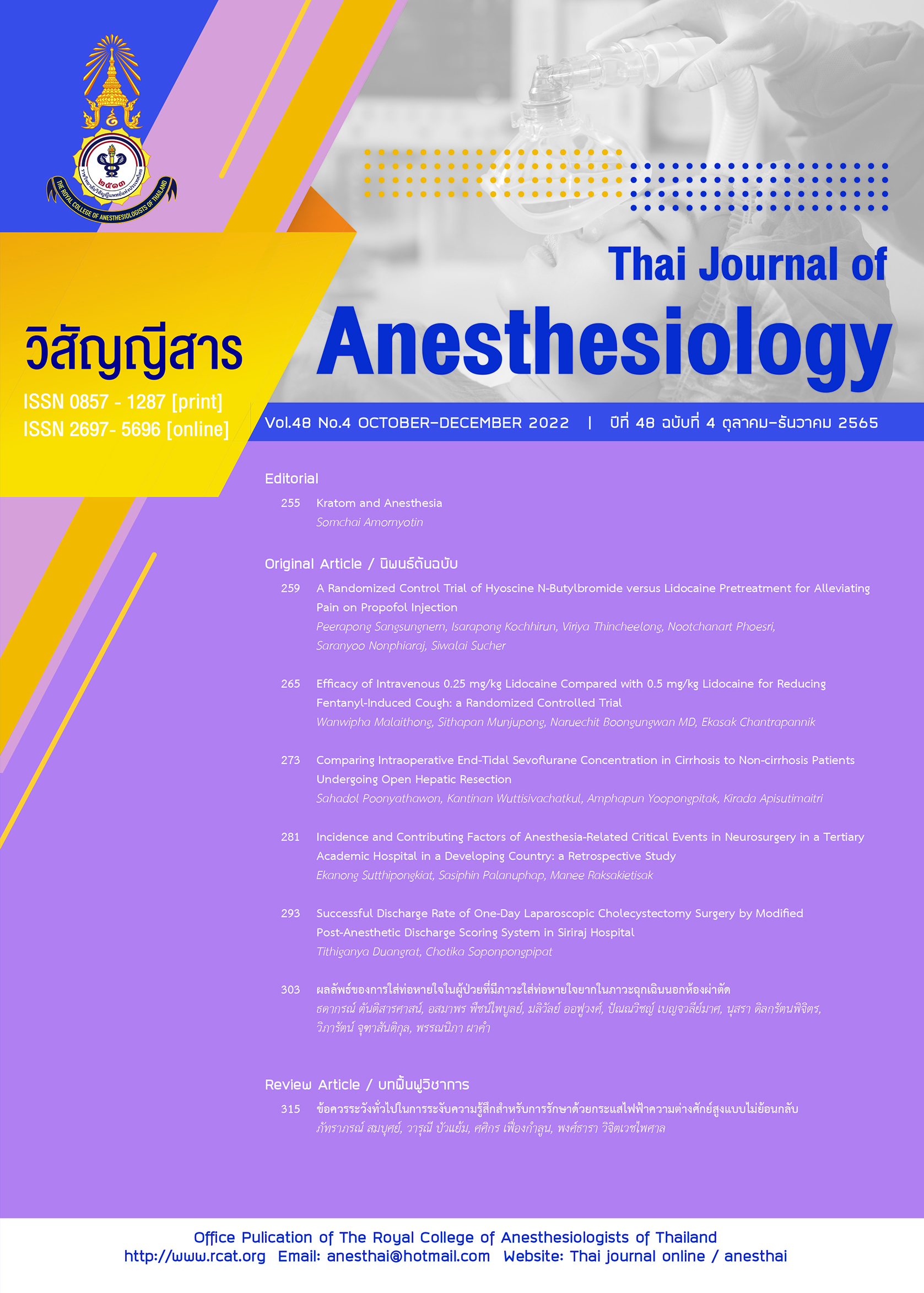Outcomes of Difficult Intubation in Emergency Condition Outside the Operating Room
Main Article Content
Abstract
Background: The Songklanagarind airway management outside the operating room practice guidelines were first developed and implemented in 2018. This study aimed to determine the success rate of emergency call for endotracheal intubation outside the operating room and other outcomes. Methods: This retrospective cohort study was conducted from January 2018 until December 2020. We determined intubation performances and outcomes of endotracheal intubation outside the operating room in patients with anticipated difficult intubation, by either anesthesiologist staff or residents. The outcomes were compared from the three years of study period. Results: During the three-year period, there were 171 airway consultations: divided into 26, 54, and 91 intubations in 2018, 2019, and 2020. The overall success of intubation was 98.8%. The rate of successful intubation in the emergency unit was significantly lower (87.5%) compared to the rate of successful intubation in the intensive care units (100.0%) and general wards (100.0%) (P=0.008). Residents claimed 76.9% of intubation success. The median waiting time was five minutes. The intubation success and the waiting time were not different among years. Conclusion: There was not significantly different between the success rate of intubation within each year. Compared to other settings, intubation performed in the emergency unit carried the greater chance of failure.
Article Details

This work is licensed under a Creative Commons Attribution-NonCommercial-NoDerivatives 4.0 International License.
References
Mosier JM, Joshi R, Hypes C, Pacheco G, Valenzuela T, Sakles JC. The physiologically difficult airway. West J Emerg Med. 2015;16:1109-17.
Asai T. Airway management inside and outside operating rooms-circumstances are quite different. Br J Anaesth. 2018;120:207-9.
Jaber S, Amraoui J, Lefrant JY, et al. Clinical practice and risk factors for immediate complications of endotracheal intubation in the intensive care unit: a prospective, multiple-center study. Crit Care Med. 2006;34:2355-61.
Martin LD, Mhyre JM, Shanks AM, Tremper KK, Kheterpal S. 3,423 emergency tracheal intubations at a university hospital: airway outcomes and complications. Anesthesiology. 2011;114:42-8.
Bowles TM, Freshwater-Turner DA, Janssen DJ, Peden CJ. Out-of-theatre tracheal intubation: prospective multicentre study of clinical practice and adverse events. Br J Anaesth. 2011;107:687-92.
Mark LJ, Herzer KR, Cover R, et al. Difficult airway response team: a novel quality improvement program for managing hospital-wide airway emergencies. Anesth Analg. 2015;121:127-39.
Yoon U, Mojica J, Wiltshire M, et al. Emergent airway management outside of the operating room-a retrospective review of patient characteristics, complications and ICU stay. BMC Anesthesiol. 2019;19:220.
Higgs A, McGrath BA, Goddard C, et al. Guidelines for the management of tracheal intubation in critically ill adults. Br J Anaesth. 2018;120:323-52.
Lewis SR, Butler AR, Parker J, Cook TM, Smith AF. Videolaryngoscope versus direct laryngoscope for adult patients requiring tracheal intubation. Cochrane Database Syst Rev. 2016;11:CD011136.
Arulkumaran N, Lowe J, Ions R, Mendoza M,
Bennett V, Dunser MW. Videolaryngoscope versus direct laryngoscope for emergency orotracheal intubation outside the operating room: a systematic review and meta-analysis. Br J Anaesth. 2018;120:712-24.
Rochlen LR, Housey M, Gannon I, et al. Assessing anesthesiology residents’ out-of-the-operating-room (OOOR) emergent airway management. BMC Anesthesiol. 2017;17:96.
Flin R, Patey R. Non-technical skills for anaesthetists: developing and applying ANTS. Best Pract Res Clin Anaesthesiol. 2011;25:215-27.


